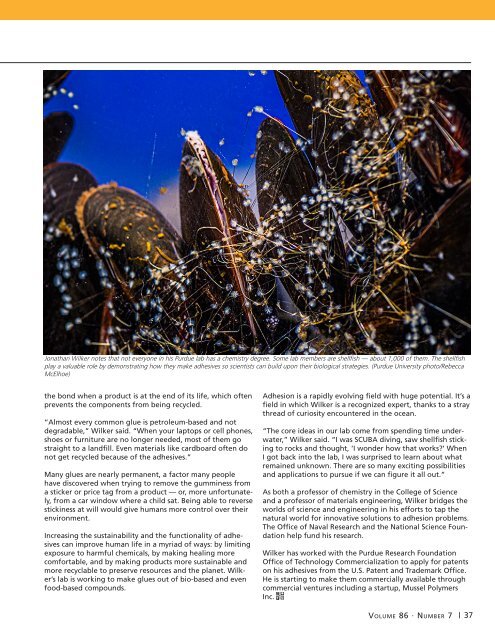CEAC-2021-07-July
You also want an ePaper? Increase the reach of your titles
YUMPU automatically turns print PDFs into web optimized ePapers that Google loves.
Jonathan Wilker notes that not everyone in his Purdue lab has a chemistry degree. Some lab members are shellfish — about 1,000 of them. The shellfish<br />
play a valuable role by demonstrating how they make adhesives so scientists can build upon their biological strategies. (Purdue University photo/Rebecca<br />
McElhoe)<br />
the bond when a product is at the end of its life, which often<br />
prevents the components from being recycled.<br />
“Almost every common glue is petroleum-based and not<br />
degradable,” Wilker said. “When your laptops or cell phones,<br />
shoes or furniture are no longer needed, most of them go<br />
straight to a landfill. Even materials like cardboard often do<br />
not get recycled because of the adhesives.”<br />
Many glues are nearly permanent, a factor many people<br />
have discovered when trying to remove the gumminess from<br />
a sticker or price tag from a product — or, more unfortunately,<br />
from a car window where a child sat. Being able to reverse<br />
stickiness at will would give humans more control over their<br />
environment.<br />
Increasing the sustainability and the functionality of adhesives<br />
can improve human life in a myriad of ways: by limiting<br />
exposure to harmful chemicals, by making healing more<br />
comfortable, and by making products more sustainable and<br />
more recyclable to preserve resources and the planet. Wilker’s<br />
lab is working to make glues out of bio-based and even<br />
food-based compounds.<br />
Adhesion is a rapidly evolving field with huge potential. It’s a<br />
field in which Wilker is a recognized expert, thanks to a stray<br />
thread of curiosity encountered in the ocean.<br />
“The core ideas in our lab come from spending time underwater,”<br />
Wilker said. “I was SCUBA diving, saw shellfish sticking<br />
to rocks and thought, ‘I wonder how that works?’ When<br />
I got back into the lab, I was surprised to learn about what<br />
remained unknown. There are so many exciting possibilities<br />
and applications to pursue if we can figure it all out.”<br />
As both a professor of chemistry in the College of Science<br />
and a professor of materials engineering, Wilker bridges the<br />
worlds of science and engineering in his efforts to tap the<br />
natural world for innovative solutions to adhesion problems.<br />
The Office of Naval Research and the National Science Foundation<br />
help fund his research.<br />
Wilker has worked with the Purdue Research Foundation<br />
Office of Technology Commercialization to apply for patents<br />
on his adhesives from the U.S. Patent and Trademark Office.<br />
He is starting to make them commercially available through<br />
commercial ventures including a startup, Mussel Polymers<br />
Inc.<br />
Volume 86 · Number 7 | 37


















